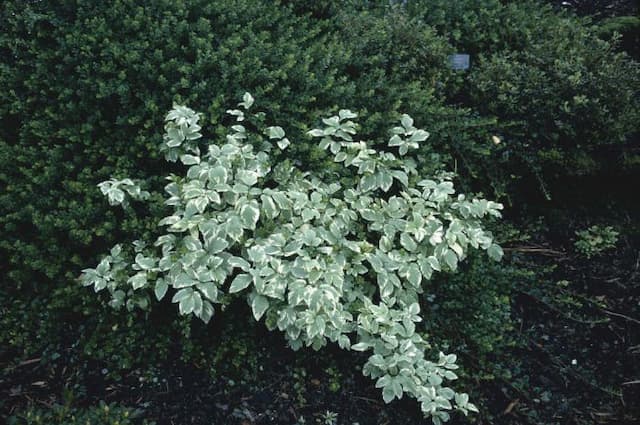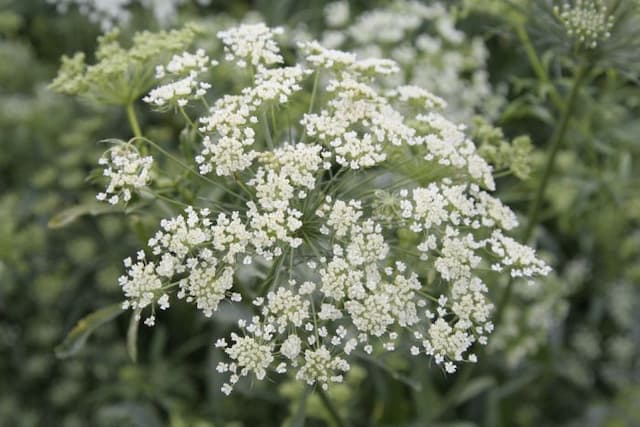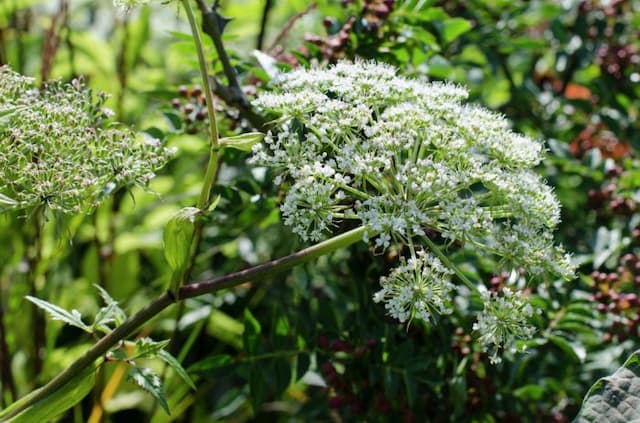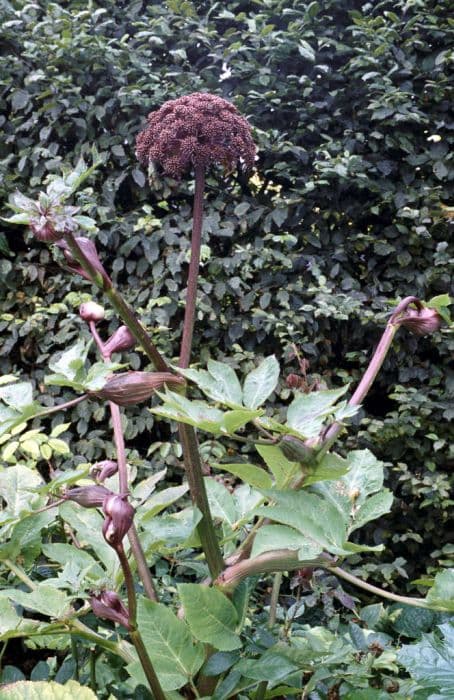Great Masterwort Astrantia maxima

ABOUT
Astrantia maxima, commonly known as great masterwort, is a perennial plant known for its distinctive and intricate flowers. The plant features a rosette of lobed, medium green leaves which are often palmate – resembling the shape of an open hand with fingers spread. From the base of the foliage, stems arise topped with flower heads that have a unique look: the actual tiny flowers are bunched together in a rounded cluster, surrounded by a ruff of papery bracts that can be pale pink or greenish-white. These bracts are often mistaken for petals and give the blossoms an exquisite, starry appearance. The flowers bloom from late spring to early summer and can have a subtle, delicate fragrance. The overall impression of the flowers is one of intricate, lacy detail, enhanced by the contrast between the true flowers at the center and the bracts that encircle them. After flowering, seed heads may form which also hold ornamental interest. The foliage of great masterwort remains attractive throughout the growing season, and the plant's leaves can form a dense, ground-covering mound. This green backdrop allows the complex structure of the flowers to stand out even more when they are in bloom. Its foliage and flowers make great masterwort a popular choice for gardeners looking to add texture and a touch of the unique to their garden beds or borders.
About this plant
 Names
NamesFamily
Apiaceae
Synonyms
Great Masterwort
Common names
Astrantia major var. maxima, Helleborus astrantia, Astrantia colchica, Astrantia carinthiaca.
 Toxicity
ToxicityTo humans
Astrantia maxima, commonly known as great masterwort, is not widely reported as a poisonous plant to humans. There is limited information regarding its toxicity, and it is generally considered non-toxic. However, as with any plant, individual sensitivities can vary, and it's always prudent to avoid ingesting parts of plants not typically recognized as food, as they can cause adverse reactions in some people.
To pets
Great masterwort is not commonly known to be toxic to pets. There is a lack of substantive evidence suggesting that Astrantia maxima poses a significant risk if ingested by animals such as dogs and cats. Nevertheless, it is always recommended to monitor pets around plants and discourage them from chewing on or ingesting plant material, as individual animals may have sensitivities or reactions to substances that are not broadly recognized as toxic.
 Characteristics
CharacteristicsLife cycle
Perennials
Foliage type
Deciduous
Color of leaves
Green
Flower color
Pink
Height
2 feet (60 cm)
Spread
2 feet (60 cm)
Plant type
Herb
Hardiness zones
5
Native area
Caucasus
Benefits
 General Benefits
General Benefits- Attracts Pollinators: Astrantia maxima is known to attract bees and butterflies, which are essential for pollination in the garden.
- Aesthetic Appeal: With its delicate star-shaped flowers and attractive foliage, it adds visual interest to garden borders and floral arrangements.
- Drought Tolerance: Once established, it has a good tolerance for drought, making it suitable for gardens with less water availability.
- Shade Tolerance: This plant can grow well in partial shade, providing options for gardeners with less sunny landscapes.
- Low Maintenance: Astrantia maxima typically requires minimal care once it is established, making it a convenient choice for busy gardeners.
- Long Flowering Period: The flowering season of Astrantia maxima extends from late spring to early fall, offering prolonged beauty in the garden.
- Wildlife Habitat: Its structure provides shelter and nesting opportunities for small wildlife, enhancing biodiversity in the garden.
- Soil Adaptability: It can adapt to a range of soil types, although it prefers moist, well-drained soils.
- Deer Resistance: Often resistant to deer, Astrantia maxima is an excellent choice for gardens in areas with high deer populations.
- Cut Flower Usage: Its blooms last well when cut, making it a favorite for bouquets and indoor flower arrangements.
 Medical Properties
Medical PropertiesThis plant is not used for medical purposes.
 Air-purifying Qualities
Air-purifying QualitiesThis plant is not specifically known for air purifying qualities.
 Other Uses
Other Uses- Astrantia maxima, commonly known as great masterwort, can be used as a natural fabric dye, providing a range of subtle shades to textiles depending on the mordant used.
- The flower heads of great masterwort can be dried and included in potpourri mixes for a delicate, unique scent and interesting texture.
- As a resilient perennial, great masterwort can be utilized in landscape design to stabilize soil and prevent erosion in sloped gardens.
- The plant is sometimes planted for its attractive geometric seed heads, which can be used in floral displays and as unique elements in craft projects.
- Astrantia maxima can be used in shadow gardens to create a feeling of depth and to add interest with its complex flower structure.
- It serves as a companion plant in vegetable gardens to attract beneficial insects that pollinate plants and help control pests.
- The long-lasting flowers of great masterwort make it suitable for creating naturalistic wedding bouquets and other event floral arrangements.
- The seeds of great masterwort can be offered to birds in the garden, particularly during winter months when natural food sources are scarce.
- As an indicator plant, Astrantia maxima can signal soil and moisture conditions in the garden, helping gardeners make informed planting decisions.
- The dense foliage of great masterwort can be used as a living mulch under taller plants, providing a living barrier against weeds and helping to retain soil moisture.
Interesting Facts
 Feng Shui
Feng ShuiThe plant Great Masterwort is not used in Feng Shui practice.
 Zodiac Sign Compitability
Zodiac Sign CompitabilityThe plant Great Masterwort is not used in astrology practice.
 Plant Symbolism
Plant Symbolism- Mystery: Astrantia maxima, commonly known as Great Masterwort, has a unique intricate blossom structure which has led it to symbolize mystery and complexity.
- Protection: The Great Masterwort was traditionally thought to have protective qualities and was used in folk medicine and magical rites, representing defense against harm.
- Unity: The myriad of tiny flowers clustered into a single head suggest unity and connectedness, symbolizing togetherness and harmony.
- Perseverance: Able to grow in both sun and partial shade and with a lengthy blooming period, it signifies endurance and the ability to thrive in diverse conditions.
 Water
WaterGreat Masterwort (Astrantia maxima) prefers consistently moist soil, so it should be watered regularly, especially during dry spells. Aim to provide about 1 inch of water weekly, which is approximately 0.623 gallons for a 10 square foot area. Allow the top inch of soil to dry out slightly between waterings, but do not let the plant become completely dry. During particularly hot or windy weather, you may need to water more frequently, possibly every few days, to maintain the necessary moisture levels.
 Light
LightGreat Masterwort thrives in partial shade, where it receives dappled sunlight or bright indirect light for the majority of the day. It can tolerate some morning sun but should be protected from the intense afternoon rays. An ideal spot would be under the canopy of deciduous trees or on the north or east side of a structure, where the plant will be shielded during the hottest part of the day.
 Temperature
TemperatureGreat Masterwort prefers moderate temperatures and fares well in USDA hardiness zones 4 through 7. It can withstand minimum winter temperatures down to about -30 degrees Fahrenheit, but during the growing season, it prefers a range between 65 to 75 degrees Fahrenheit, for optimal growth. The plant may struggle in temperatures exceeding 85 degrees Fahrenheit and should be shaded and watered to prevent stress.
 Pruning
PruningPruning Great Masterwort is vital for promoting vigorous growth and maintaining a neat appearance. Deadheading spent flowers encourages a second bloom and prevents self-seeding. Cut back the foliage in late fall or early spring to make way for new growth. Typically, pruning can be done annually, after the first flush of blooms fade, which usually occurs by late summer.
 Cleaning
CleaningAs needed
 Soil
SoilGreat Masterwort prefers a moist, well-draining soil rich in organic matter with a pH range of 5.5 to 7.5. A mix of garden loam, compost, and leaf mold or peat moss is ideal to provide the nutrients and structure necessary for healthy growth.
 Repotting
RepottingGreat Masterwort does not need frequent repotting; it may only require repotting every few years if the plant has outgrown its current container or if the soil has become compacted or depleted of nutrients.
 Humidity & Misting
Humidity & MistingGreat Masterwort thrives in moderate to high humidity levels, typical of outdoor garden environments, which usually provide adequate humidity without the need for additional measures.
 Suitable locations
Suitable locationsIndoor
Place in bright, indirect light with high humidity.
Outdoor
Plant in partial shade, moist soil, and mulch.
Hardiness zone
4-7 USDA
 Life cycle
Life cycleThe life cycle of Astrantia maxima, commonly known as Great Masterwort, begins with seed germination, which typically occurs in spring when soil temperatures warm sufficiently. After germination, the seedlings develop a rosette of basal leaves during their juvenile phase, focusing on root establishment and foliage growth. As the plant matures, it enters the vegetative stage where it forms a robust clump of star-shaped, palmate leaves. By early to midsummer, Astrantia maxima reaches the flowering stage, displaying umbels of tiny, pale pink or white flowers surrounded by a ruff of bracts that can attract various pollinators. Following pollination, the flowers develop into seed heads that gradually dry and release seeds, thereby completing the reproductive cycle. In autumn, the above-ground growth typically dies back, with the plant overwintering as dormant rootstock and ready to regrow the following spring.
 Propogation
PropogationPropogation time
Spring-Early Summer
The most popular method of propagating the Astrantia maxima, commonly known as Great Masterwort, is by division. This method is typically conducted in early spring before new growth begins or in the fall after the plant has finished flowering. The process involves carefully digging up the plant and gently teasing apart the clumps of roots into smaller sections, ensuring that each section has several growth points. These divisions can then be replanted in a well-drained soil enriched with organic matter, spacing them about 12 to 15 inches apart (roughly 30 to 38 centimeters) to allow sufficient room for growth. Watering in the divisions thoroughly after planting helps establish them in their new location, and mulching can aid in retaining moisture while the plants become established.









